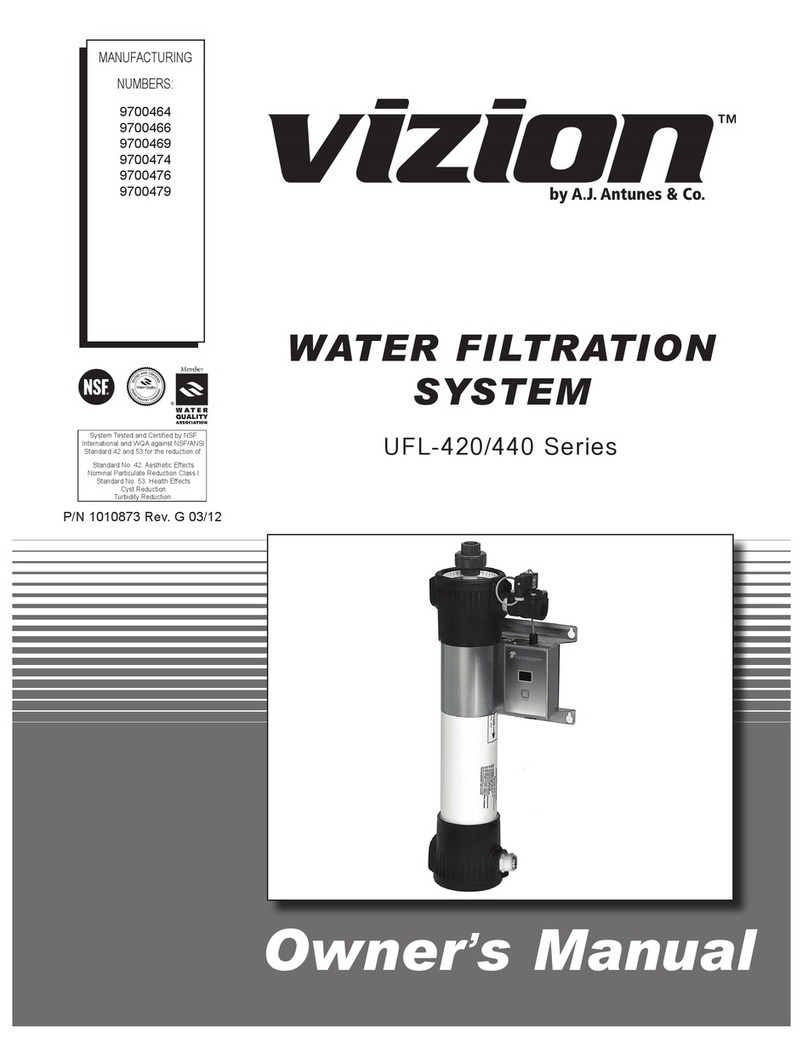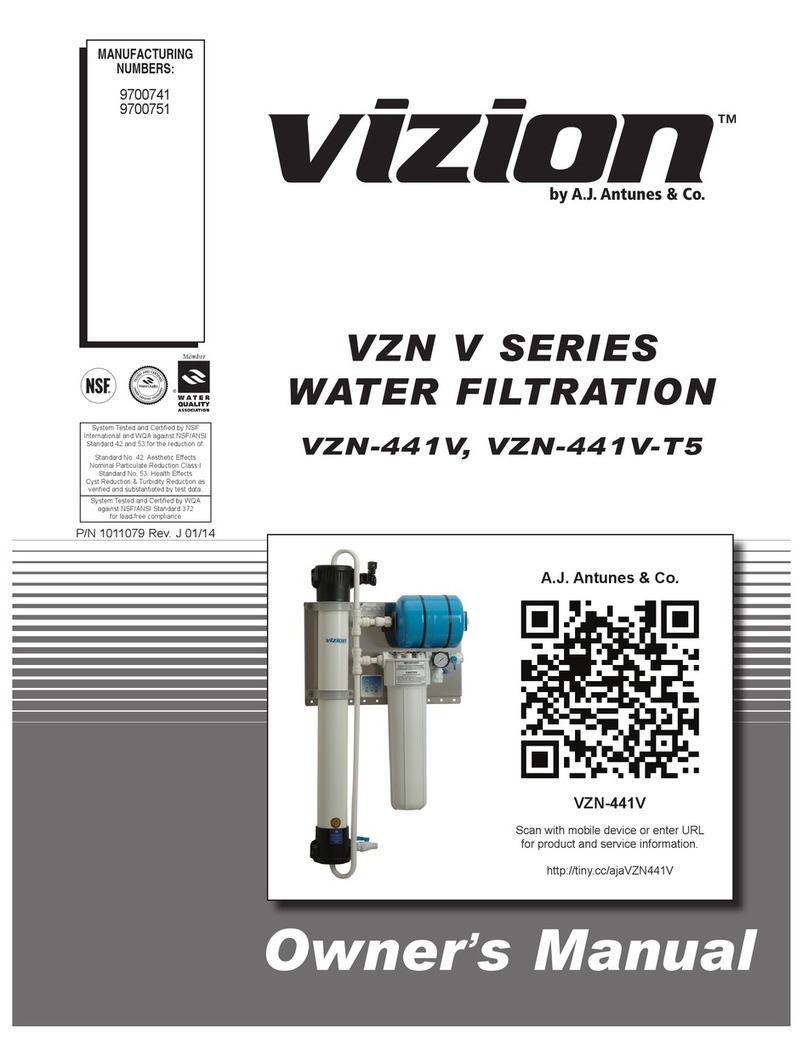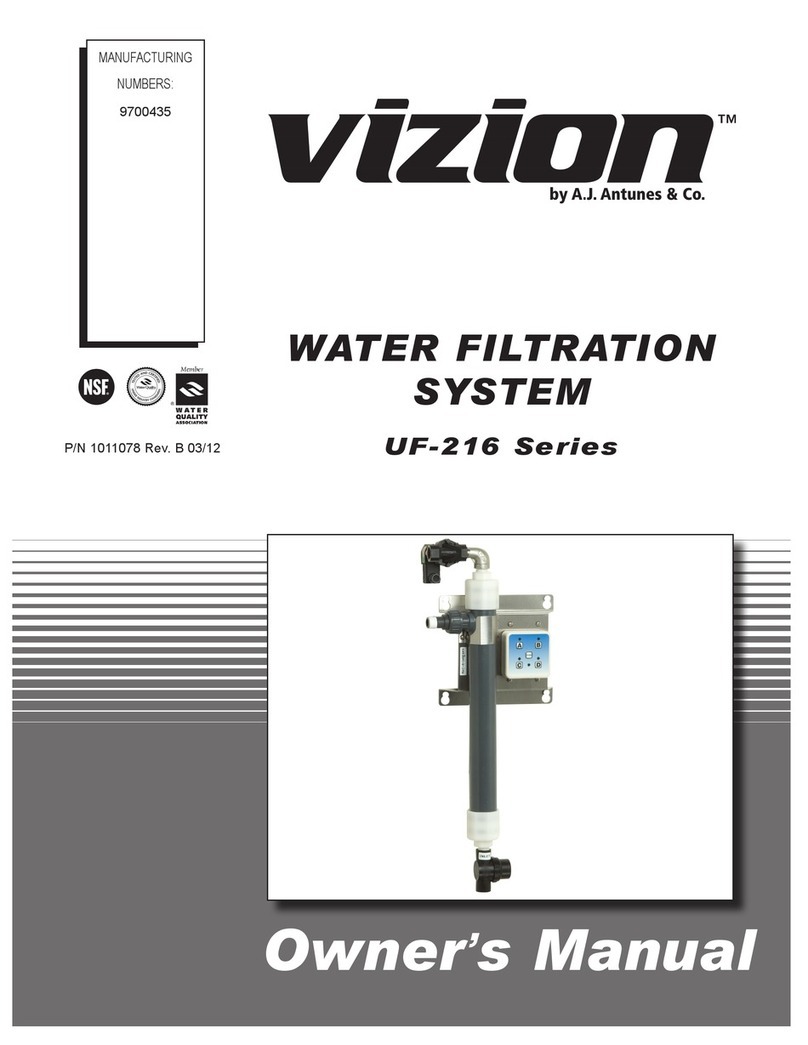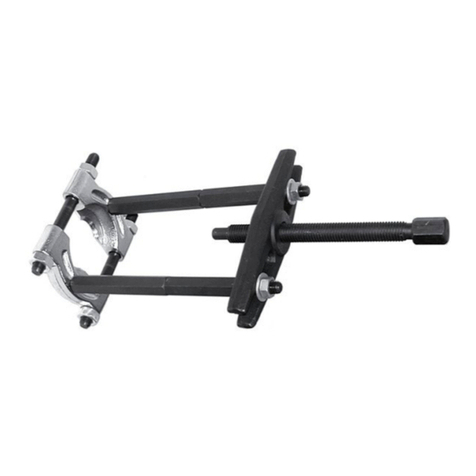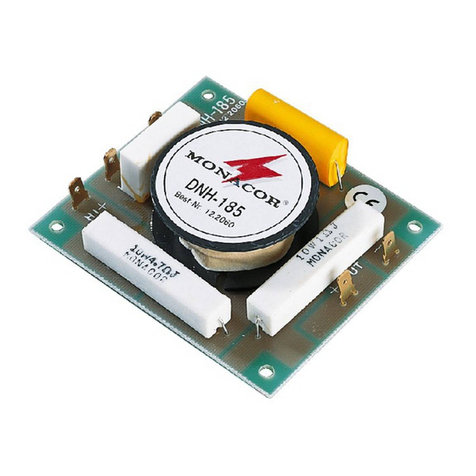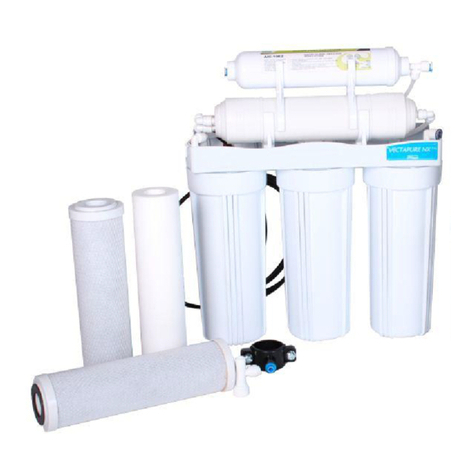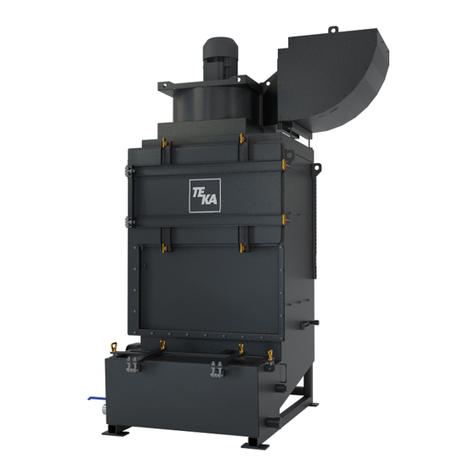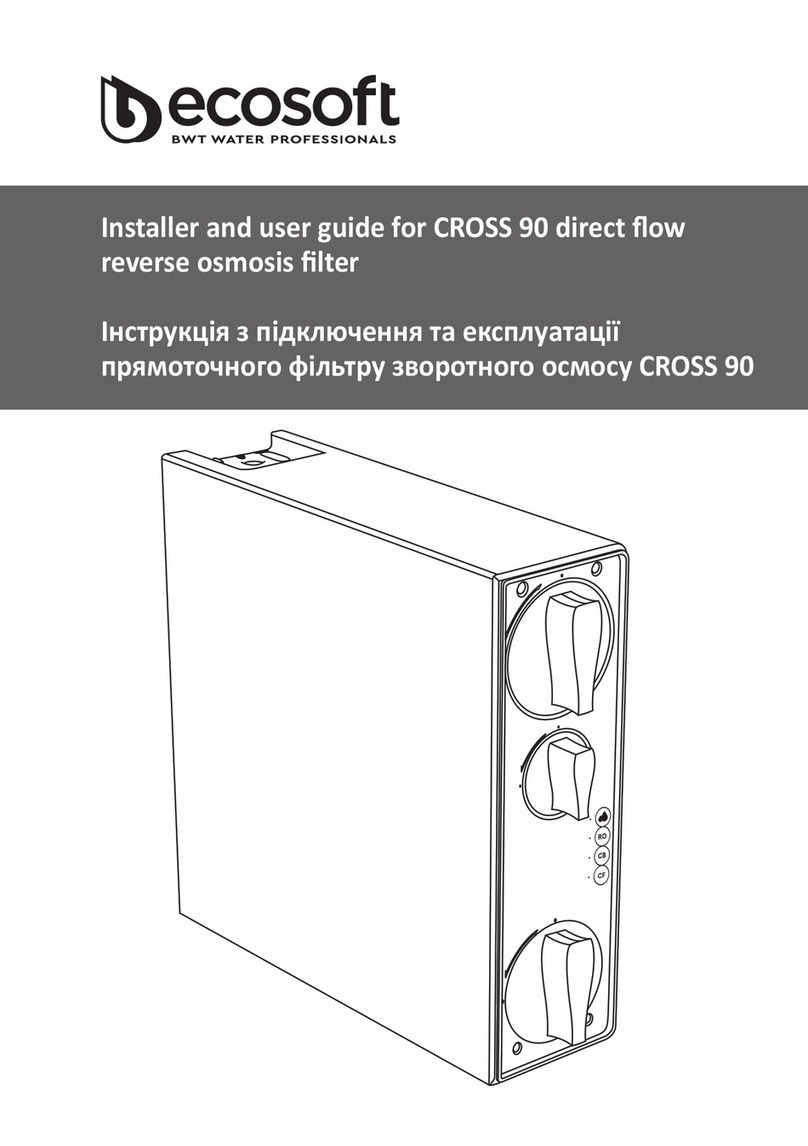Vizion TAP-42x Series User manual

TOTAL ASSURANCE
PACKAGE
TAP-42x Series
Owner’s Manual
P/N 1010976 Rev. G 03/12
Manufacturing
nuMbers:
9700800
9700801
9700810
9700811
Cartridge Tested and Certified by NSF
International against NSF/ANSI
Standard 42 and 53 for the reduction of:
Standard No. 42: Aesthetic Effects
Nominal Particulate Reduction Class I
Standard No. 53: Health Effects
Cyst Reduction
Turbidity Reduction.
TAP-421 shown

TAP-42X SERIES
2
A.J. Antunes & Co.
P/N 1010976 Rev. G 03/12
General
The TAP Series is an innovative filtration system that proprie-
tary multi-bore hollow fiber membranes as well as carbon ele-
ment to provide the latest innovation in filtration technology.
This manual provides the safety, installation and operating
procedures for the TAP-Series water filtration systems. We
recommend that all information contained in this manual be
read prior to installing and operating the system. Your TAP-
Series system is manufactured from the finest materials
available and is assembled to our strict quality standards.
This system has been tested at the factory to ensure depend-
able trouble-free operation.
OWNER INFORMATION
TABLE OF CONTENTS
IMPORTANT! Keep these instructions for future reference. If the system changes
ownership, be sure this manual accompanies the equipment.
Owner Information ...............................................................2
General............................................................................... 2
Warranty Information.......................................................... 2
Service/Technical Assistance ............................................. 3
Important Safety Information ..............................................3
Specifications .......................................................................5
Replacement Cartridges .................................................... 5
Operating Weights ............................................................. 5
Dimensions......................................................................... 5
Electrical Cord & Plug Configurations................................ 5
Performance Data Sheet......................................................7
Filter Cartridge Capacities.................................................. 7
System Capacities ............................................................. 7
Water Condition Equipment Guidelines.............................7
Performance Claims for Percent Reduction....................... 7
Installation.............................................................................8
Unpacking .......................................................................... 8
Equipment Setup................................................................ 8
Mounting the System ....................................................... 10
Drain Hose Connection.....................................................11
Rinse Hose Connection ....................................................11
System Inlet Connection ...................................................11
Filtered Water Permeate Outlet Connection .....................11
Starting the Smart Controller ........................................... 12
Rinsing the Ultra Filter Cartridge...................................... 12
Rinsing the Carbon Element and Plumbing
(TAP-421 units only)......................................................... 13
Sanitizing the System and Lines...................................... 14
Operation.......................................................................... 15
Manual Flushing............................................................... 15
System Power Loss ........................................................ 15
Operation.............................................................................15
Viewing Filtration Element Data....................................... 15
Viewing Sensor Readings ................................................ 15
Maintenance........................................................................16
Replacing the Ultra Filter Cartridge.................................. 16
Replacing the Carbon Element (TAP-421 ONLY) ............ 17
Resetting the Carbon Element Accumulated Total Value .... 18
System Sanitization.......................................................... 18
Troubleshooting .................................................................21
Wiring Diagram...................................................................22
Recommended Equipment Schematic.............................22
Replacement Parts .............................................................23
Limited Warranty ................................................................28
Warranty Information
Please read the full text of the Limited Warranty in this
manual.
If the system arrives damaged, contact the carrier immediate-
ly and file a damage claim with them. Save all packing materi-
als when filing a claim. Freight damage claims are the respon-
sibility of the purchaser and are not covered under warranty.
The warranty does NOT extend to:
improper use.
components.
any preset control or safety device.

TAP-42X SERIES
3
A.J. Antunes & Co.
P/N 1010976 Rev. G 03/12
Purchased From:
Date of Purchase:
Model No.:
Serial No.:
Mfg. No.:
IMPORTANT SAFETY INFORMATION
In addition to the warnings and cautions in this manual, use
the following guidelines to safely operate the system:
as described in this manual.
cord or plug; if it is not working properly, or if it has
been damaged or dropped.
-
nel only. Contact A.J. Antunes & Co. for repair.
water.
of Massachusetts Plumbing Code 248 CMR shall be
adhered to. The use of saddle valves are not permitted.
Please consult your local plumber.
The following warnings and cautions appear throughout this
manual and should be carefully observed.
service or maintenance on the unit.
local electrical codes and any other applicable codes.
Service/Technical Assistance
If you experience any problems with the installation or opera-
tion of your system, contact A.J. Antunes & Co. at 1-630-784-
1000, or toll free in the United States at 1-800-253-2991.
Fill in the information in the next column and have it handy
when calling for assistance. The serial number is on the
specification plate located on the system.
OWNER INFORMATION (continued)
IMPORTANT
A.J. Antunes and Company reserves the right to change specifications and product
design without notice. Such revisions do NOT entitle the buyer to corresponding
changes, improvements, additions or replacements for previously purchased equipment.
TO FOLLOW THESE INSTRUCTIONS COULD
RESULT IN SERIOUS INJURY OR DEATH.
- Do NOT modify the power supply cord plug. If it
does not fit the outlet, have a proper outlet installed
by a qualified electrician.
- Do NOT use an extension cord with this unit.
the manufacturer, its service agent, or a similarly quali-
fied person.
local plumbing code and any other applicable code.
To reduce water pressure, install a water pressure
regulator and set to suit the application.
the permeate water pressure) must not exceed 45 psi
(310 kPa).
installed on the circuit to this system.
electrical bonding jumper must be installed across the
inlet and outlet pipes serving this unit.

TAP-42X SERIES
4
A.J. Antunes & Co.
P/N 1010976 Rev. G 03/12
IMPORTANT SAFETY INFORMATION (continued)
Protect from becoming dry
If the membrane dries out, irreversible damage to the Ultra
Filter membrane may result. Protect the filter from becoming
dry by keeping it wet and sealed at all times.
Protect from freezing
If the Ultra Filter membrane freezes during operation or stor-
age, irreversible damage to the membrane and brittle cracking
of the cartridge or housing may result.
Protect from direct sunlight or other UV sources
Avoid long-term exposure to direct sunlight or other UV
sources. The Ultra Filter should be stored in a dark location.
Protect from high temperatures or abrupt variation in
temperature
The maximum operating temperature is 104°F (40°C). Avoid
abrupt variations in temperature. Any temperature variation
should be made slowly.
Protect from rough handling or dropping
Mechanical damage, external breakage, and/or internal break-
age of the filter can result if the system is dropped or bumped.
Handle with care at all times during transportation and instal-
lation.
Protect from organic solvents and concentrated acids
Prevent any and all contact of the membrane with strong sol-
vents, solvents containing chlorine, or concentrated acids. Do
NOT use strong solvents or concentrated acids on any plastic
parts of the filter system. Examples of some solvents to avoid:
acetone, methyl acetate (nail polish remover); hexane (spot
removers); turpentine, toluene (paint thinners); dry cleaning
solutions, insecticides.
Protect from abrasive material
The membranes must be protected from abrasive materials
like shavings left in a pipe. Abrasive materials in contact with
the membrane can cause irreversible damage to the mem-
brane. All pipes must be flushed clean before installing the fil-
ter. All plastic parts of the filter system must be protected from
sharp objects like knives, sand paper, or other tools. Cutting
or nicking a plastic part can weaken it and cause a leak. Do
NOT use abrasive cleansers on any plastic parts.
Protect from water hammer
The system must be protected from shock, pressure surges,
or pulsation that may occur inside water pipes. Water ham-
mer occurs in pipes when a valve or faucet shuts quickly.
Install a water hammer arrestor (pressure vessel containing
compressed air separated from the water by a diaphragm) to
reduce pressure shock.
CAUTION
This equipment is to be installed to comply with the
basic plumbing code of the Building Officials and Code
Administrators, Inc. (BOCA) and the Food Service
Sanitation Manual of the Food and Drug Administration
(FDA).
CAUTION
Water Flow Regulator Assemblies are NOT interchange-
able. Operating the system with the wrong Water Flow
Regulator or without a regulator can damage the sys-
tem, cause personal injury, and voids the warranty!

TAP-42X SERIES
5
A.J. Antunes & Co.
P/N 1010976 Rev. G 03/12
SPECIFICATIONS
Dimensions
CAUTION
All electrical connections must be in accordance with
local electrical codes and any other applicable codes.
Electrical Cord & Plug Configurations
A
B
C
(TAP-421 shown)
Replacement Cartridge Part Number
TAP-420 Ultra Filter L-420 7000411
TAP-421 Single pack Carbon 7000669
Replacement Cartridges
Kit Model
Number Description Configuration
0012146
DC Power Supply
100 - 240 VAC
Includes the
4 plug adaptors
below
US
NEMA 1-15 (2 pin)
or NEMA 5-15
(3 Pin)
Euro
CEE 7/16
3112
AUS
(2 Pin)
BS 1363
Model &
Mfg. No.
Width
(A)
Depth
(B)
Height
(C)
TAP-420
9700800
9700801
33”
(84 cm)
13”
(33 cm)
28”
(71 cm)
TAP-421
9700810
9700811
33”
(84 cm)
13”
(33 cm)
36”
(91 cm)
Model &
Mfg. No.
Operating
Weight
TAP-420
9700800
9700801
50 lbs.
(23 kg)
TAP-421
9700810
9700811
70 lbs.
(32 kg)
Operating Weights
NOTE: PLUG STYLE
M AY VAR Y
US
NEMA 1-15 (2 PIN)
or NEMA 5-15
(3 PIN)
BS 1363
UKUK
EURO
CEE 7/16
AS/NZS 3112
(2 PIN)
AUS

TAP-42X SERIES
6
A.J. Antunes & Co.
P/N 1010976 Rev. G 03/12
SPECIFICATIONS (continued)
Figure 1. System Components
Permeate
Tank
System
“SMART
Controller”
Differential Pressure
Sensor
UFL
Ultrafiltration
Cartridge
Carbon
Element
Housing
(TAP-421
units only)
System
Outlet
(Front)
Outlet
Ball Valve
(Manual)
Dual Check Valve
Assembly
with outlet
Pressure Gauge
Permeate Solenoid
Valve (Automatic)
Flow
Meter
DC Power
Supply
System
Outlet
Solenoid
Valve
(Automatic)
Inlet
Solenoid
Valve
(Automatic)
Inlet
Ball
Valve
(Manual)
INLET
Rinse
Ball Valve
(Manual)
DRAIN
Outlet
Ball Valve
(Manual)
Dual Check Valve
Assembly
with outlet
Pressure Gauge
Front View
Left-hand Side View Right-hand Side View
Carbon
Element
Housing
(TAP-421
units only)
Carbon
Element
Housing
(TAP-421
units only)
OUTLET
RINSE
System
Drain (Rear)
Rinse
(Rear)
System
Inlet
(Front)

TAP-42X SERIES
7
A.J. Antunes & Co.
P/N 1010976 Rev. G 03/12
PERFORMANCE DATA SHEET
Filter Cartridge Capacities
Maximum Operating Pressure 100 psig (690 kPa)
Maximum Operating Temp. 104°F (40°C)
Minimum Operating Temp. 40° F (4° C)
pH Range 3-10
MWCO 100 kD
System Capacities
Cartridge Tested and Certified by NSF
International against NSF/ANSI
Standard 42 and 53 for the reduction of:
Standard No. 42: Aesthetic Effects
Nominal Particulate Reduction Class I
Standard No. 53: Health Effects
Cyst Reduction
Turbidity Reduction
Cartridge has been tested according to NSF/ANSI Standard
42 and 53 for reduction of the substances listed below. The
concentration of the indicated substances in water enter-
ing the system was reduced to a concentration less than or
equal to the permissible limit for water leaving the system, as
specified in NSF/ANSI 42 or 53. While testing was performed
under standard laboratory conditions, actual performance may
vary.
Performance Claims for Percent Reduction
Substance Influent
Challenge
Concentration
Reduction
Requirement
cyst1minimum 50,000/L 99.95%
Turbidity 11+/1 NTU
Particulate Class I
Particles 0.5 to <
1µm
at least 10,000
particles /mL
85%
1based on the use of microspheres or Cryptosporium parvum oocysts
Model
Mfg. No.
Gal./Liters
Per Min.
(max)
Carbon
Element
Capacity
UF
Length
Number
of
Carbons
TAP-420
9700800
9700801 7.9 gal.
(30 liters)
0
20 in.
(51 cm)
0
TAP-421
9700810
9700811
60,000 gal.
(227,000 liters) 1
NOTE: The NSF Information provided above applies to
the TAP System’s Ultra-Filter Cartridge.
If your Inlet Turbidity (NTU) is... Then the Additional Equipment required or recommended is...
Less than 1 NTU Required: No additional equipment.
Recommended: Inlet Water Strainer (180 micron/80 mesh screen)
Greater than 1 NTU Required: Inlet Water Strainer (180 micron/80 mesh screen)
The following table describes the required or recommended equipment to be used with your filtration system based on the Inlet
Water Pressure and Inlet Turbidity.
WATER CONDITION EQUIPMENT GUIDELINES

TAP-42X SERIES
8
A.J. Antunes & Co.
P/N 1010976 Rev. G 03/12
INSTALLATION
Unpacking
1. Open the large box. It should contain:
A. Plate mounted TAP-42x Series system with UFL
cartridge installed (Figure 2).
B. One 20-foot coil of flexible hose.
C. Accessory Box.
2. Open the Accessories box. It should contain:
A. Padded Envelope containing:
B. Carbon Element (TAP-421 units only).
C. Carbon Element Housing (TAP-421 units only).
D. Mounting Bracket.
3. Remove all packing materials and protective coverings
from the system.
4. Remove the information packet. To prevent any delay in
obtaining warranty coverage, fill out and mail the war-
ranty card.
NOTE: If any parts are damaged, contact A.J. Antunes &
Co. IMMEDIATELY at 1-800-253-2991 (toll free in the U.S.
and Canada) or 1-630-784-1000.
SUGGESTED TOOLS AND SUPPLIES FOR INSTALLATION
The following tools and supplies are suggested to make the
installation easier:
bleach
The TAP System uses the following connections (Figure 1):
System Inlet Male 3/4" NPT
System Outlet
(Product Water) Male 3/4" NPT
Drain 3/4" I.D. Hose Barb
Rinse Outlet 3/4" GHT (Garden Hose)
When making a plumbing connection to the system, use a
back-up wrench on the supporting plumbing. Always use a
quality, approved pipe sealant or thread seal tape on pipe
threads. Do not allow pipe sealant inside pipes.
Do NOT over tighten the connections. Use plastic fittings
when connecting to the plastic connections of the system.
If soldered plumbing is used, do NOT apply heat to, or near,
the filtration system. Use union (O-ring seal) connections for
ease of installation and future servicing.
TAP-420 TAP-421
Figure 2. TAP-420 and TAP-421 Systems
Equipment Setup
GENERAL
When placing the system into service, pay attention to the
following guidelines:
ELECTRICAL
The line voltage must match the voltage on the specification
label. The plug on the power cord must match the appropriate
outlet. Do NOT connect the system to a switched electrical
outlet.
PLUMBING
NOTE: The system must be connected to the COLD water
line. Do not connect the system to the hot water line.

TAP-42X SERIES
9
A.J. Antunes & Co.
P/N 1010976 Rev. G 03/12
INSTALLATION (continued)
INLET WATER PLUMBING
If desired, a “T” or Cross Fitting with cap or plug can be
installed between the Inlet Valve and the System Inlet. This
fitting can be used for draining and sanitizing the system and
downstream plumbing.
The plumbing leading to the system must be flushed clear of
all debris before connecting to the system inlet. Hold a bucket
at the inlet water line and slowly open the inlet water valve.
Allow the pipe to flush until all debris is removed.
Figure 3. Proper Drain Plumbing
Figure 4. Smart Controller Inputs
2” (5.1 cm)
minimum
2” (5.1 cm)
minimum
Floor
Drain
Secure
End
Drain Line
from System
Drain Line
from System
Secure
End
Drain
Standpipe
DRAIN LINE PLUMBING
The drain line flushes particle buildup out of the system during
self cleaning and must be able to support the flow rate when
the system flushes.
The flow rate from the flush depends on the inlet water pres-
sure, inlet pipe size, and system selected. The drain opening
should be as large or larger than the inlet plumbing line.
The drain line leading out of the system should be as short as
possible, sloping downward without kinks or loops. Be sure
the drain used is not blocked or restricted.
Protect the system from possible back contamination by
installing an air gap between the drain connection of the
system and the drain (Figure 3). This gap in the line, with no
physical contact between the system and drain, prevents con-
tamination of the system in the event of a backed-up drain.
NOTE: Make sure the end of the drain line is positioned
and secured at least 2 inches above the drain so that the
water flow is directed into the drain without splashing.
ATTACH THE SMART CONTROLLER AND WIRING
HARNESSES
1. Using the provided Velcro®fastener, connect the Smart
Controller to the system as shown in Figure 2.
2. Connect the two wiring harness connectors to the
appropriate points on the bottom of the Smart Controller
(Figure 4).
NOTE: Do NOT plug the power transformer into the
SMART controller at this time. Mount the system to the
wall first before attaching the power.
ULTRAFILTER
1
2
3
VIEW
CARBON
SYSTEM
NO FLUSH DURING PEAK
% REMAINING
ULTRAFILTER
CARBON
CHANGE
Wiring
Harness
Connection
Points
USB Port
(used for
downloading
saved data)
Power
Transformer
Connection
Point

TAP-42X SERIES
10
A.J. Antunes & Co.
P/N 1010976 Rev. G 03/12
CAUTION
Due to its weight and size, the TAP System MUST be
mounted with the provided Mounting Bracket. Read
the ENTIRE section on Mounting the System BEFORE
attempting to mount the TAP System. Use care when
lifting heavy objects.
Mounting the System
NOTE: Use caution when lifting and mounting the sys-
tem. The system MUST be mounted using the provided
Mounting Bracket.
INSTALLATION (continued)
Secure Mounting Bracket
to wall studs using
appropriate hardware
The System is
designed to “hang” from
the Mounting Bracket
Back Plate
(holes along bottom for
additional mounting stability)
Follow these steps to secure the Mounting Bracket to the wall
and seat the TAP System on the Mounting Bracket:
1. Use a level and a stud finder to attach the Mounting
Bracket securely to the wall with the appropriate mount-
ing hardware (Figure 5).
2. The Mounting Bracket is designed so that the TAP
System can be lifted and “hung” on the Mounting
Bracket. With assistance, lift the TAP System and seat
it onto the Mounting Bracket securely (Figure 5).
3. Secure the bottom portion of the TAP System to the
wall using the holes provided. Make sure the mounting
hardware secures the system into wall studs or use the
appropriate mounting hardware (Figure 5).
Figure 5. Mounting (TAP-421 Shown)
IMPORTANT
Allow 20 inches on either the left or right side of the
unit for cartridge replacement. For TAP-421 units,
allow 3-4 inches below the unit to remove the Carbon
Element Housing.
The TAP System comes with a Mounting Bracket (P/N
0505558) to assist in mounting the system securely (Figure 5)
Before mounting the system, consider these important points
when choosing a mounting location:
system should be mounted with 20 inches on either the
left or right side of the unit to allow proper access when
changing cartridges.
NOT ABOVE an
appropriate electrical outlet.
-
tion processes.
and hardware capable of supporting 70 lbs or more.
appropriate heavy duty mounting hardware.
The system is pre-assembled to a back plate. The back plate
has mounting holes across the bottom portion to secure the
bottom of the system to the wall. Some of the bottom mount-
ing holes may be obscured. Plan your mounting accordingly.
INSTALLING CARBON ELEMENT & HOUSING
(TAP-421 UNITS ONLY)
1. Insert the Carbon Element into the Carbon Element
Housing (Figure 6).
2. Screw the Carbon element Housing into the Carbon
Filter Head. Do NOT overtighten.
Carbon
Element
Housing
Carbon
Element
Head
Carbon
Filter
Element
Figure 6. Installing Carbon Element (TAP-421 ONLY)
NOTE: Mount the system to the wall BEFORE attaching the
Carbon Element and Carbon Element Housing (TAP-421 Only)
NOTE: Secure the bottom portion of the system to the wall
using the holes provided at the bottom of the Back Plate.

TAP-42X SERIES
11
A.J. Antunes & Co.
P/N 1010976 Rev. G 03/12
INSTALLATION (continued)
Drain Hose Connection
The TAP System is shipped with a coil of braided tubing (20
feet) designed to direct the Drain Valve Solenoid water to the
drain. Refer to Figure 7 and follow these steps:
1. If necessary, cut a length of braided tubing so that it
reaches the drain from the appropriate valve.
2. Connect one end of the hose to the Drain Valve
Solenoid and secure with a provided Worm Clamp.
3. Direct the other end of the hose to the drain.
NOTE: The drain MUST be able to accommodate a flow
up to 7.9 gpm. The drain hose MUST have an air gap
between the end of the hose and the drain.
Left-hand Side View
3/4”
Garden
Hose
Connection
3/4”
Garden Hose
(not supplied)
Direct hose
to Drain
Rinse Hose Connection
Figure 7. Attaching the Drain Hose
Figure 8. Attaching the Rinse Hose
CAUTION
Do NOT use the Rinse Valve connection for consumable
water. Because the Carbon Element is after the Rinse
Valve, the Rinse Valve water may have an objectionable
taste.
Rinse Hose Connection
The TAP System has a standard 3/4” garden hose connection
at the Rinse Valve (Figure 8).
1. Obtain a length of 3/4” garden hose long enough to
reach from the Rinse Valve connection to the drain.
2. Install a gasket in the end of the hose (non-drain end).
3. Connect the hose to the Rinse Valve fitting. Use a back-
up wrench on the fitting if required (Figure 8).
4. Direct the other end of the hose to the drain. Secure as
necessary (Figure 8).
NOTE: The drain MUST accommodate a flow of up to 7.9
gpm.
System Inlet Connection
The System Inlet (Figure 9) has a 3/4” NPT male thread at
the Inlet Valve. Do NOT overtighten fittings. The plastic ball
valve can crack due to over-tightening.
Use plastic fittings and a pipe thread sealant approved for use
on PVC fittings when making connections.
Filtered Water Permeate Outlet Connection
The system outlet (Figure 9) has a 3/4” NPT male thread at
the Outlet Valve. Do NOT overtighten a fittings. The plastic
ball valve can crack due to overtightening.
Use plastic fittings and a pipe thread sealant approved for use
on PVC fittings when making connections.
Right-hand Side View
Drain Hose Connection
Secure Hose
with Worm
Clamp
Direct Hose
to Drain
System
Inlet
Drain
Connection
Permeate
Outlet
Figure 9. TAP-42X Inlet and Outlet Connections
Right Side View Left Side View

TAP-42X SERIES
12
A.J. Antunes & Co.
P/N 1010976 Rev. G 03/12
INSTALLATION (continued)
NOTE: The system is designed to supply water even with
the power off. However, with power off, the system will
not flush or monitor any usage.
SETTING THE INTERNAL CLOCK
After setting the Product Type, the Display flashes "CL" indi-
cating that the Internal Clock must be set before any other
action can take place. The unit beeps as a reminder to set
this value. To set the clock:
1. Press and hold (in order) the VIEW
the red System LED illuminates and “ -- “ appears on
the display.
2. Release all buttons.
01.
4. Press the FLUSH button. The Clock Set program uses
the following format for date and time:
YY; MM; DD; HH (0-23); MM
time.
NOTE: The system uses military time. If the local time is
3:45 PM on July 2, 2008, the clock would be set as 08; 07;
02; 15; 45.
Rinsing the Ultra Filter Cartridge
The Ultra Filter Cartridge is pre-installed with the TAP System
before shipment. This cartridge must be rinsed before placing
the system into operation to remove air and the shipping solu-
tion from the Ultra Filter Cartridge.
Follow these steps to rinse the Ultra Filter Cartridge.
1. Manually close the Inlet Valve (Figure 11).
2. Make sure a drain hose is connected to the Rinse
Valve. Direct this hose to a drain.
Starting the Smart Controller
NOTE: Make sure that ALL ball valves are closed before
starting the system.
Follow these steps to power up the system:
1. After the system is mounted, connect the power supply
to the bottom right of the Smart Controller (Figure 4).
2. Select the appropriate adaptor for your power outlet
and attach the adapter to the transformer.
3. Plug the transformer into the appropriate outlet that has
power to it at all times.
NOTE: Do NOT plug the power transformer into an outlet
that will be switched off. Failure to supply power to the
system at all times may result in short cartridge life or
bad tasting water.
ULTRAFILTER 1
2
3
VIEW
CARBON
SYSTEM
NO FLUSH DURING PEAK
% REMAINING
ULTRAFILTER
CARBON
CHANGE
Figure 10. TAP System Control Panel
System
Display
3. Manually open the Rinse Valve (Figure 11).
4. Enter the 06 program. Press and hold (in order) the
VIEWSYSTEM LED illumi-
nates and “ -- ” appears on the display (Figure10).
NOTE: Ultra Filter Cartridge must be rinsed to drain
before use. Rinsing to drain removes storage solution
and air. Do NOT rinse into carbon if present. Carbon life
and/or performance may be affected.
06” and press the
FLUSH button to start the rinse program. The system
displays d3 and begins to depressurize.
6. Manually open the Inlet Valve. Press the FLUSH
button to start the r1 stage.
7. Wait until the display flashes r1 (approximately 1
minute). The system beeps.
8. Press the FLUSH button. The system starts the r2
stage.
9. Wait until the display flashes r2 (approximately 15
minutes) The system beeps.
10. Manually close the Rinse Valve.
11. Press the FLUSH button to start the r3 stage.

TAP-42X SERIES
13
A.J. Antunes & Co.
P/N 1010976 Rev. G 03/12
12. Wait until the display flashes r3 (approximately 15
minutes). The system beeps.
13. Manually open the Rinse Valve.
14. Press the FLUSH button to start the r4 stage (Rinse
Flow stage).
15. Wait until the display flashes r4 (approximately 5
minutes). The system beeps.
16. Manually close the Rinse Valve.
17. Press the FLUSH button to start the r5 stage.
18. Wait for 1 minute. Water flows through the UFL housing
and out of the Drain Solenoid Valve.
19. The system begins the r6 stage. The system completes
depressurization and displays d3.
20. Repressurize the system using the 08 program.
Press and hold the VIEW
SYSTEM LED illuminates and “ -- ” appears on the dis-
play.
08”.
22. Press the FLUSH button to start the Pressurize System
program.
The system repressurizes and makes water available through
the system.
INSTALLATION (continued)
Rinsing the Carbon Element and Plumbing
(TAP-421 units only)
The Carbon Element is used on TAP-421 units only. The
Carbon Element must be rinsed before using the system the
first time and after replacing the Carbon Element.
1. Direct water from the System Outlet to a drain.
2. Turn on the water to the system.
3. Allow water to flow through the Carbon Element and
Carbon Element Housing to flush out trapped air and
any debris that may be present.
4. To help remove trapped air from the Carbon Element
Housing, press the red button on the top of the housing
until water just begins to come out of the button.
5. Flush the Carbon Element for at least 5 minutes.
NOTE: Do NOT consume water used during this process.
6. When the Carbon Element flushing is complete, turn off
the water to the system.
7. Reconnect the water to service. The system is now
ready for use.
8. For new piping installations: After making the con-
nection to the System Outlet:
a. Open the faucet or tap closest to the filter system
b. Slowly open the Inlet Valve.
c. Allow the pipe to flush until all debris is removed.
Figure 11. Manual Valve Locations (TAP-420/421)
Inlet
Ball
Valve
(Manual)
Rinse
Ball
Valve
(Manual)
Outlet
Ball Valve
(Manual)
Front View
Left-hand Side View

TAP-42X SERIES
14
A.J. Antunes & Co.
P/N 1010976 Rev. G 03/12
INSTALLATION (continued)
Sanitizing the System and Lines
NOTE: If installed, remove the Carbon Element from the
system BEFORE Sanitizing.
The plumbing must be sanitized to eliminate possible contam-
ination that may have occurred during the installation process.
One ounce (30 ml) of liquid chlorine bleach (regular bleach,
unscented 6 % sodium hypochlorite) can be used to sanitize
the plumbing. The amount of bleach to use depends on the
system installed and the amount of plumbing downstream of
the TAP System.
NOTE: Follow the handling and safety instructions
supplied with the bleach.
1. Follow the procedures in the Rinsing the Ultra Filter
Cartridge section of this manual.
2. Remove the Carbon Element from the system
(TAP-421 systems only).
3. Turn off the water to the system.
4. Open the faucet closest downstream to the system.
5. Allow the system and plumbing to drain.
6. If an inlet sanitation fitting is installed, remove the plug
or disconnect the water line at the inlet of the system.
Allow the water to drain out of the system.
7. Pour the bleach into the inlet sanitation fitting or inlet
water line using a cup or funnel. Be careful not to spill
bleach onto clothing or skin.
8. Reattach the plug on the sanitation fitting or inlet
water line.
9. Slowly turn on the water supply to the system.
10. Allow water to flow through the system and out of the
open faucet until the smell of bleach is present.
11. Close the faucet.
12. Let the system stand without water flow for at least 15
minutes to allow the bleach to sanitize the pipes.
13. After 15 minutes without water flow, open the faucet.
14. Allow water to flow through the system until the
presence of bleach is gone.
15. Open all other faucets in line with the system to flush
any bleach from the plumbing.
16. Close all open faucets.
17. If your system uses Carbon Element (TAP-421 sys-
tems only) and you removed them in step 2, follow the
steps in the Replacing the Carbon Element in the
Maintenance section of this manual.
18. If necessary, reinstall the Carbon Element or install a
new Carbon Element.
19. Repressurize the system using the 08 program.
Press and hold the VIEW
SYSTEM LED illuminates and “ -- ” appears on the
display.
08”.
21. Press the FLUSH button to start the Pressurize System
program.
The system repressurizes and makes water available through
the system. Sanitation is complete.

TAP-42X SERIES
15
A.J. Antunes & Co.
P/N 1010976 Rev. G 03/12
CAUTION
The system continues to filter water even after a power
loss but it will NOT flush. Therefore, running the system
without power may shorten the life of the filtration ele-
ments. Make sure the system always has power.
Operation
The TAP System is designed to operate with little to no user
intervention. The system monitors and flushes itself automati-
cally.
Manual Flushing
The TAP System is designed to automatically flush but can
also be manually flushed when desired. To manually flush the
system:
1. Press and hold the FLUSH button for 3 to 4
seconds.
2. The system enters the FLUSH program and automati-
cally performs the following stages while displaying the
stage code on the display throughout the process:
F1 (Close Permeate Solenoid Valve stage)
F2 (Close Inlet Solenoid Valve stage)
F3 (Open Drain Solenoid Valve stage)
F4 (Open Inlet Solenoid Valve stage)
F5 (Close Drain Solenoid Valve stage)
F6 (Open Permeate Solenoid Valve stage)
NOTE: The system automatically performs these stages
3. Flushing is complete once the system completes the
F6 stage of the FLUSH program.
System Power Loss
The TAP System is designed to run with constant power.
Thus, the power cord should always be plugged into an
appropriate power outlet that will not be switched off.
In the event of a power loss, the TAP System:
1. Aborts any active valve program.
2. Resets the valves to normal operation (pressurized/
water available).
3. Sounds an alert to notify the operator of the power loss.
4. Records the time of the power loss into the controller
memory.
5. Displays the EV-20 event code (indicating a loss of
power).
6. The system beeps 4 times every 10 seconds for
approximately 2 minutes. Then it beeps once every 30
seconds.
NOTE: Be sure to restore power to the system. The sys-
tem displays the EV-21 code when power is restored to
the system.
Viewing Filtration Element Data
The TAP System monitors the lifespan of the filtration ele-
ments and can display the percent-of-life remaining for the
selected component. Follow these steps to view the Filtration
Element Data:
1. Press the VIEW button to cycle through the Ultra Filter
and Carbon LEDs.
2. Pressing the VIEW button again steps to the next
component.
3. The system displays the percent-of-life remaining for
the selected component in the display.
Viewing Sensor Readings
The TAP System uses the Flow Meter and Differential
Pressure Sensor to monitor the Flow Rate and Differential
Water Pressure respectively.
The system also uses measurements to determine when to
automatically flush and monitors the effectiveness of the flush
operations. To view this data:
1. Press and hold both the VIEW
Red SYSTEM LED illuminates.
2. Press the VIEW button to scroll through the green LEDs
(numbered 1, 2, and 3 - Figure 12) which indicate the
following data:
LED 1 (top): Used to determine when the system
automatically flushes and measures the effectiveness
of flush operations.
LED 2 (middle): Flow Rate, in gallons per
minute (gpm)
LED 3 (bottom): Differential Water Pressure, in
pounds per square inch (psi)
3. To exit, press and hold the FLUSH button until the red
SYSTEM LED turns off.
OPERATION
Figure 12. TAP System Control Panel
LEDs
1, 2, and 3
ULTRAFILTER 1
2
3
VIEW
CARBON
SYSTEM
NO FLUSH DURING PEAK
% REMAINING
ULTRAFILTER
CARBON
CHANGE

TAP-42X SERIES
16
A.J. Antunes & Co.
P/N 1010976 Rev. G 03/12
MAINTENANCE
Snap
Ring End
Cap
Ultra Filter
Housing
Ultra Filter
Cartridge
End Cap
O-rings
Cartridge
O-ring
Cartridge
O-ring
End Cap
O-rings
Snap
Ring
End
Cap
Remove the Elbow
from this point
on either side
of the system to
access the
UF Cartridge
Figure 13. Replacing the Ultra Filter Element
Replacing the Ultra Filter Cartridge
NOTE: Always install a new Carbon Element after replacing
the UFL cartridge.
This procedure involves depressurizing the system, replacing
the UFL cartridge, and then repressurizing the system.
DEPRESSURIZE THE SYSTEM
1. Depressurize the system using the 07 program.
Simultaneously press the VIEW
system LED illuminates and the system displays “ -- “
on the display.
07.
3. Press the FLUSH button.
The system performs the 07 program, which consists of
the following stages:
d1 (Close Inlet Valve stage)
d2 (Open Drain Valve stage)
d3 (Close Permeate Valve stage)
4. When the 07 program completes, place a bucket under
one end of the Ultra Filter Cartridge Housing.
5. Refer to Figure 13 (and inset). Locate the elbow fitting
on the desired side of the cartridge and push the collet
squarely in against the face of the fitting. With the collet
held in this position, the fitting can be removed from the
tubing. Water drains into the bucket. Discard this water.
NOTE: Make sure there is enough room next to the system
to remove the cartridge.
6. Remove the Snap Ring from the Ultra Filter housing.
Grab the raised lug with a pair of pliers and pull towards
the center of the end cap and away. The ring should lift
out of its groove.
7. Remove the End Cap, End Cap O-ring, and Cartridge
from the housing (Figure 13).
NOTE: If the cartridge does not easily come out of the
housing, remove the opposite End Cap for assistance
during Step 4.
8. Inspect the cartridge O-rings and end cap O-ring for
nicks or cuts. Replace as needed.
9. Lubricate all O-rings with a food-grade silicone lubri-
cant. Apply a light coating of lubricant to the inside
center tube at both ends of the new cartridge.
10. Record the serial number of the new cartridge. The
cartridge serial number is engraved on one end of the
11. Install the End Cap O-ring on the End Cap and insert
the End Cap into the end of the new cartridge.
12. Position the new cartridge and End Cap at the housing
and gently insert into the housing.
13. Press the End Cap into position until it is fully seated
and the Snap Ring groove is visible.

TAP-42X SERIES
17
A.J. Antunes & Co.
P/N 1010976 Rev. G 03/12
Replacing the Carbon Element (TAP-421 ONLY)
The life of a Carbon Element depends on the overall quality
of the water in the area. Follow these steps to replace the
Carbon Element:
1. Turn off water to the system by closing the Inlet valve
and the Outlet valve.
2. Run the 03 program. Press and hold the VIEW and
-- “
appears on the display.
03.
4. Press the FLUSH button.
The system performs the 03 program, which consists of
the following stages:
C1 (Close Inlet Valve stage)
C2 (Open Drain Valve stage)
C3 (Open Permeate Valve stage)
5. When the 03 program completes, press and hold the
RED Pressure Relief Button on the top of the Carbon
Element Housing (Figure 14) to lower the water level
inside the housing by 2 to 3 inches.
6. Remove the Carbon Element Housing.
O-Ring
Carbon
Element
Housing
Carbon
Filter
Element
Carbon
Element
Head
RED Pressure
Relief Button
Figure 14. Replacing the TAP Carbon Element
MAINTENANCE (continued)
14. Install the Snap Ring by guiding the non-lugged end
into the groove first, pushing outward and working
around the ring until it snaps into place.
NOTE: Make sure that the Snap Ring is fully seated
before turning the water on.
15. Re-attach the elbow fitting that was disconnected in
Step 5 (Figure 13 and inset). Push the fitting onto the
tubing until it comes into contact with the internal tubing
stop. Rotating the fitting slightly during installation helps
make the connection slide past the O-ring seal.
NOTE: Make sure the fitting is completely inserted onto
the tubing past the O-ring. A loose connection results in
leaking at the point of connection.
16. Rinse the new Ultra Filter cartridge before placing the
system back into operation. Follow the Rinsing the
Ultra Filter Cartridge and Sanitizing the System
and Lines procedures in the Installation section of this
manual to complete the cartridge change.
17. When rinsing is complete, repressurize the system.
08” and press the
FLUSH button to start the Pressurize program.
7. Empty any water into a drain and discard the old
Carbon Element. See Figure 14.
8. Inspect the O-ring on the Carbon Element Housing.
Replace the O-ring if it is cracked, twisted, or missing.
9. Lubricate the O-ring with an approved food grade lubri-
cant and install into the Carbon Element Housing.
10. Install the new Carbon Element into the Carbon
Element Housing.
NOTE: Make sure the End Seal gaskets are in place on
both ends of the Carbon Element. The gasket is retained
on the end of the element in the recessed groove. Be
careful that the gasket does not fall off the element while
placing the element into the bowl.
11. Screw the Carbon Element Housing (containing the
Carbon Element) into place. Tighten the Carbon
Element Housing until it stops. The housing will come to
a hard stop at the end of the thread. Use a filter wrench
if necessary.
12. Direct the outlet of the system to drain.
NOTE: It is important to direct the system outlet to drain
as the water resulting from Steps 13 through 17 should
NOT be used.
13. Next, repressurize the system using the “08"program.
To enter the program, press and hold (in order) the
VIEWSYSTEM LED illumi-
nates and “ -- “ appears on the display.
08”.

TAP-42X SERIES
18
A.J. Antunes & Co.
P/N 1010976 Rev. G 03/12
MAINTENANCE (continued)
Resetting the Carbon Element Accumulated
Total Value
The TAP System uses the Carbon Element Accumulated Total
feature to measure the lifespan of the Carbon Element.
After installing the Carbon Element, the Carbon Element
Accumulated Total value must be reset. This ensures that
system maximizes the life of the Carbon Element.
1. Reset the Carbon Element Accumulated Total using
the 04 program. Simultaneously press the VIEW and
SYSTEM LED illuminates and “ -- “
appears on the display.
04.
3. Press the FLUSH button to start the program. The
system automatically resets the Carbon Element
Accumulated Total. The display returns to “ -- “.
4. Press the FLUSH button again to return the system to
normal operation.
15. Press the FLUSH button to start the Pressurize System
program. This allows the system to pressurize when the
Inlet valve is opened and make water available to the
Carbon Element.
16. Turn on the water to the system by opening the Inlet
Valve and allow water to flow through the Carbon
Element and Housing to rinse out trapped air and any
carbon fines that may be present.
To help remove trapped air from the Carbon Element
Housing, press the red button on the top of the housing
until water just begins to come out of the button.
17. Rinse the Carbon Element for at least 5 minutes.
NOTE: Do not consume the water used for rinsing the
Carbon Element.
18. When the Carbon Element rinsing completes, manually
close the Inlet Valve and reconnect the water to service.
19. When the system is reconnected, turn on the water by
manually opening the Inlet Valve and Outlet Valve. The
system is ready for use. System Sanitization
The system and downstream plumbing should be sanitized at
least once a year.
When necessary, follow the Sanitizing the System and
Lines procedure in the Installation section of this manual.

TAP-42X SERIES
19
A.J. Antunes & Co.
P/N 1010976 Rev. G 03/12
MAINTENANCE (continued)
NOTE: The system beeps every time a button is pressed.
NOTE: When in normal operating mode, pressing both the ▲ and ▼ buttons displays the current software version.
POWER LOSS TO SYSTEM (SYSTEM UNPLUGGED OR SUPPLY INTERRUPTED)
FLUSH (BUTTON)
Press and hold to run a Flush cycle. The system automatically performs the following stages:
VIEW (BUTTON) Normal Operating Mode
Toggles between UFL cartridge % of life and Carbon Element % of life
VIEW (BUTTON) – SENSOR READINGS
1. Press and hold (in order): VIEW
2. The red System LED illuminates.
3. Press the VIEW
4. To exit Sensor Readings, press the FLUSH button until red LED turns off.
ERROR CODE DESCRIPTIONS
EC-01
Flow Rate is greater than 0 gpm
EC-08
less than ½ of the discharge amount)
EC-02 - Differential Pressure is greater than 45 psid
EC-09 - Memory data re-initialized
EC-03 - Differential Pressure is greater than 0 psid,
EC-10
EC-06 - Flush Flow is less than 0.75 gallon EC-11
EC-07 - Flow is greater than 10 gpm EC-12 - Flow switches erratic
EC-13 - EEPROM bad
EVENT CODE DESCRIPTIONS

TAP-42X SERIES
20
A.J. Antunes & Co.
P/N 1010976 Rev. G 03/12
MAINTENANCE (continued)
SERVICE MENU ACCESS
Press and hold in order, the VIEW
1. The red SYSTEM LED illuminates and the “--” appears in the display.
2. Release all buttons. The system displays “--”.
FLUSH button
4. To exit the Service Menu, press the FLUSH button until the red LED turns off.
“--” - Exit Service Level 2 13 - Set Differential Pressure Sensor to 0 psi
01 - Set Clock (Year; Month; Day; Hour 0-23; Minute) 14
02 - Set Flush Time Hour and Minute (Hour 0-23; Minute) 15 - Clear Displayed Error Codes (Data stays in memory)
03 - Change Carbon Element 20 - Set Valve Times (Factory use only)
04 - Reset Carbon Element Accumulated Total 21 - Set Forward Flush Time (Factory use only)
05 - Set Maximum Gallons for Carbon
Element (x 10,000)
22 - Set Maximum VER Value (Factory use only)
06 - Rinse New UFL Membrane and reset UFL Total 23 - Set Flush Trigger Point (VER Value) (Factory use only)
07 - Depressurize UFL System 24 - Reset to Factory Values
08 - Pressurize System 25
09 - Toggle Valves (Green LED illuminated when valve is
26
10 - Dump User Data out USB (serial) port 27 - Set VER Factor (Factory use only)
11 - Dump Events out USB (serial) port 28
buttons.
Note: Items 25 & 26 are in versions 2.3 AC and 3.3 DC. Items 27 & 28 are in version 2.4 & 3.4 (as of 8-10-07 not released).
PROGRAM DESCRIPTIONS
03 - (Change Carbon Element)
06 - (Rinse New UFL Membrane)
06 program (See Service Menu Access above)
07 - (Depressurize UFL System) program (see below)
d3. When the system beeps, operator opens both the Rinse Ball Valve and the Inlet Ball Valve.
Press FLUSH.
r1 stage. Operator - wait for 1 minute. The system beeps. Press FLUSH
r2 stage: Operator - wait for 15 minutes. The system beeps. Manually close the Rinse Ball Valve. Press FLUSH.
r3 stage: Operator - wait for 15 minutes. The system beeps. Manually open the Rinse Ball Valve. Press FLUSH.
r4 stage: Operator - wait for 5 minutes. The system beeps. Manually close the Rinse Ball Valve. Press FLUSH.
r5 stage: Operator - wait for 1 minute as the system automatically opens the Drain Valve.
r6 stage: The system closes the Inlet Valve - the system is depressurized.
07 - (Depressurize UFL System)
08 - (Pressurize System)
This manual suits for next models
2
Table of contents
Other Vizion Water Filtration System manuals
Popular Water Filtration System manuals by other brands
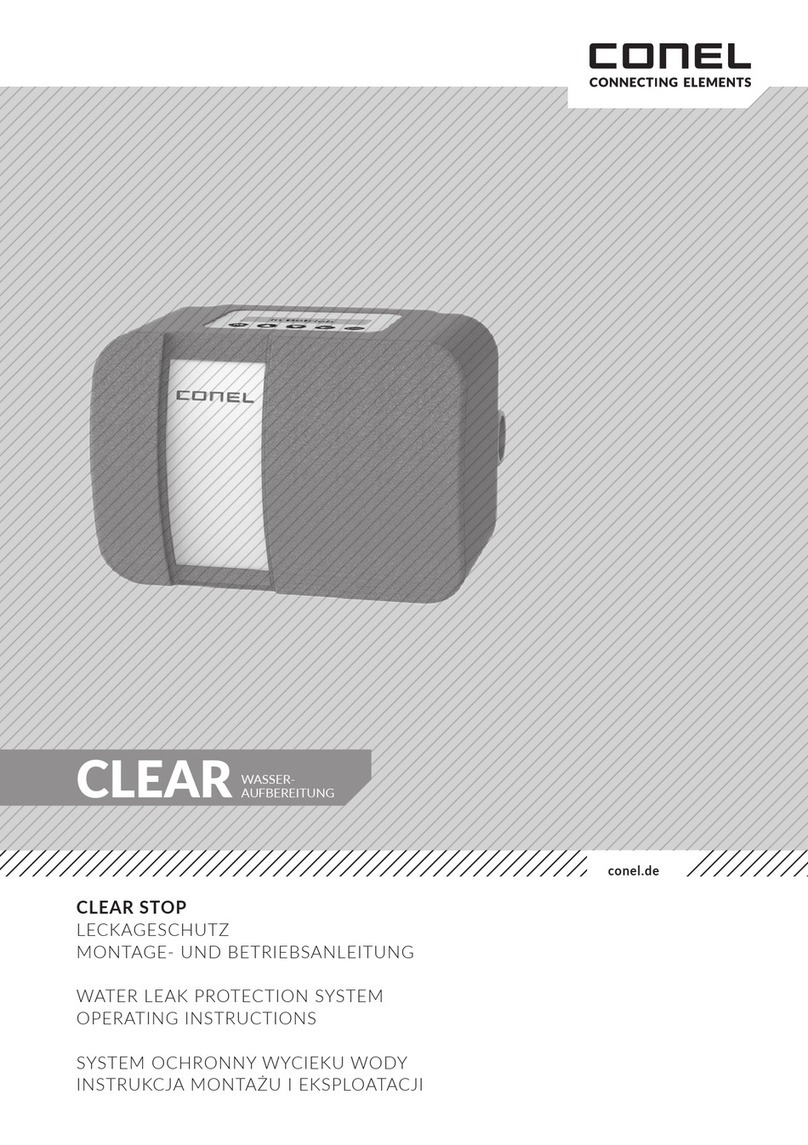
Conel
Conel CLEAR STOP operating instructions

Judo
Judo JHF-T Installation and operating instructions
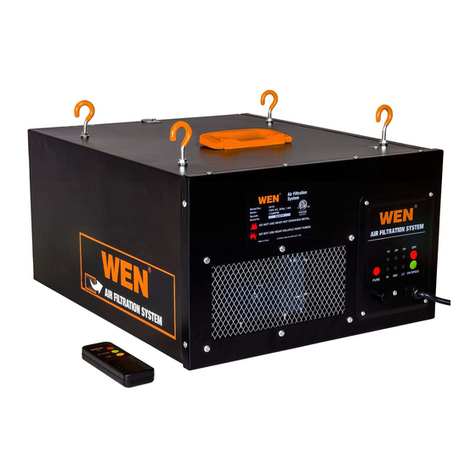
Wen
Wen 3410 Replacement guide
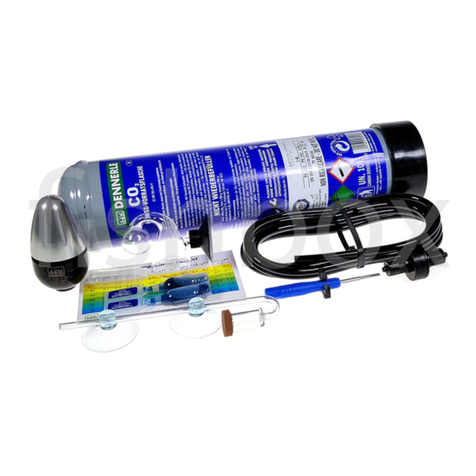
Dennerle
Dennerle CarboSTART E200 + Special Edition operating instructions
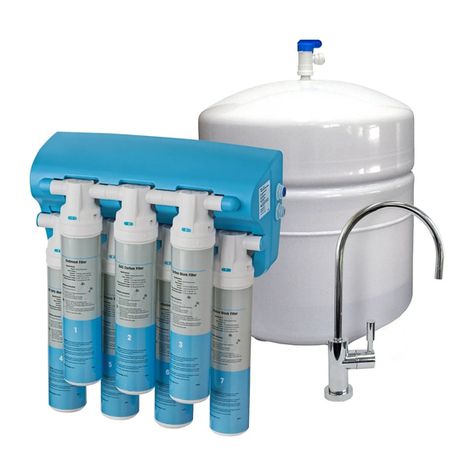
Simple Water Service
Simple Water Service 7QCRO Installation, operation & service
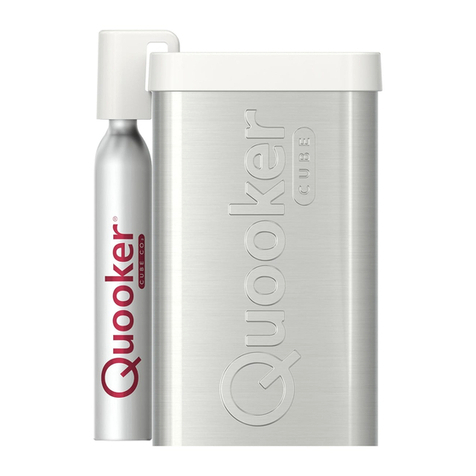
Quooker
Quooker CUBE installation guide
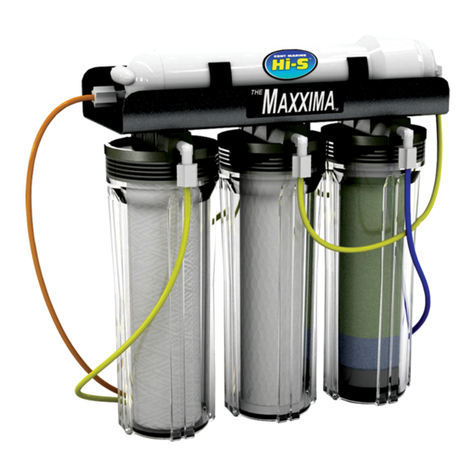
kent marine
kent marine MAXXIMA MAX24 instructions
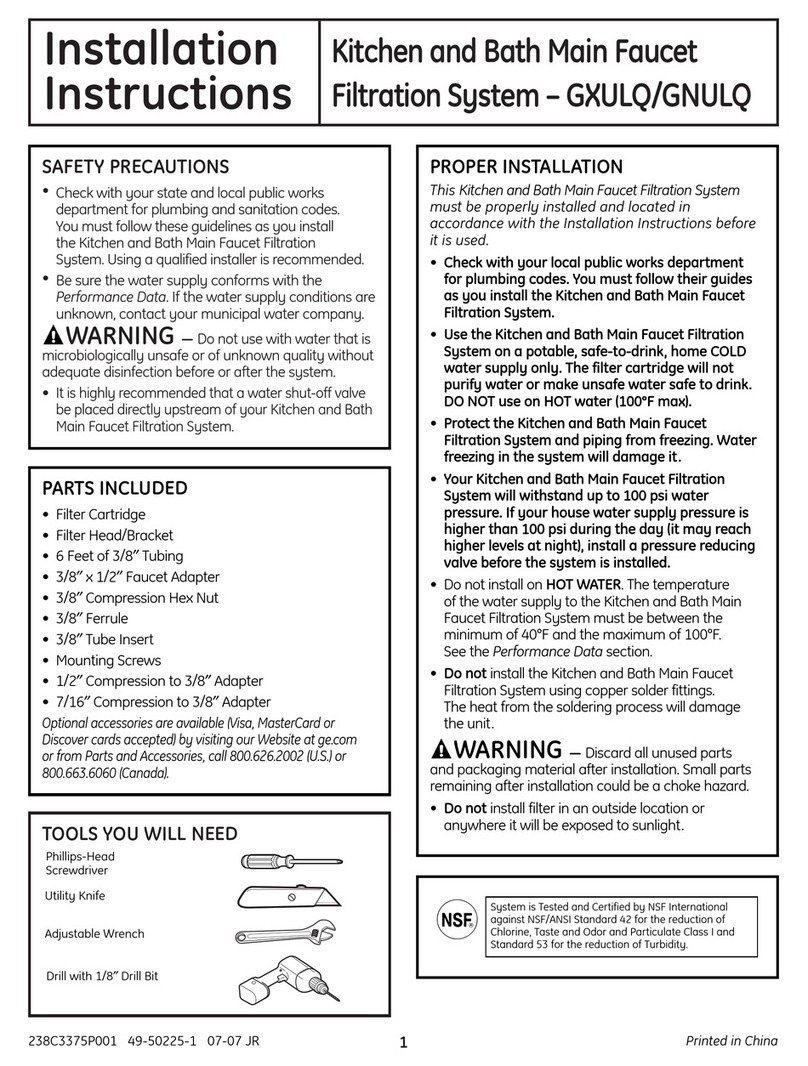
GE
GE GNULQ installation instructions
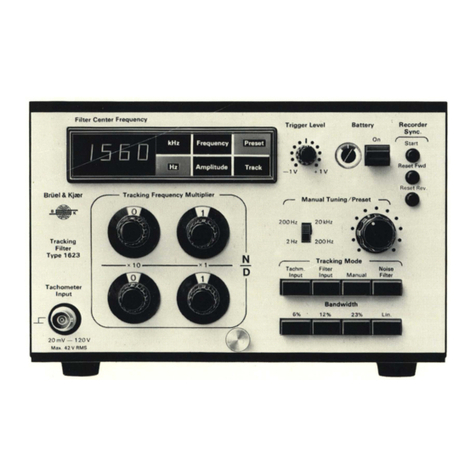
BRUEL & KJAER
BRUEL & KJAER 1623 instruction manual

Ferplast
Ferplast BLUWATERFALL user manual

Fresh Water Systems
Fresh Water Systems GTS-550S installation instructions
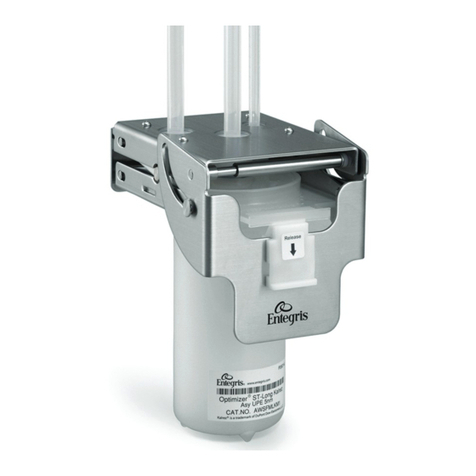
entegris
entegris Optimizer ST2 Installation and use manual

